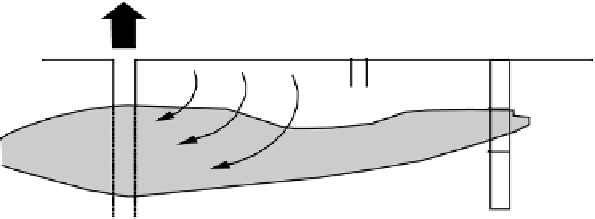Environmental Engineering Reference
In-Depth Information
15.5.2.2.
Bioventing
This process makes it possible to air the unsaturated zone so that micro-
organisms in the ground can breathe better and degrade the pollutants (see Figure
15.10).
It involves depressing unsaturated ground and introducing air circulation
centered on and in the direction of each point of extraction. This circulation ensures
the indigenous micro-organisms present in the zone considered receive sufficient
oxygen, which will enable them to degrade the pollutants (bioventing). Moreover,
the renewal of air in pores of the ground modifies the chemical balance between the
various phases present.
Thus, in passing through the contaminated zones, the air takes care of
contaminants. These vapors are recovered at the points of vacuum extraction, and
possibly treated at the surface (venting). Let us note that this process makes it
possible to treat the unsaturated zones. It is used in the presence of biodegradable
products and volatile products (chlorinated solvents, gasolines, BTEX, etc.).
A process similar to thermal high temperatures exists, called venting. It involves
heating the contaminated ground while extracting the air from the ground. The
purpose of heating is to support desorption of contaminants strongly sorbed on the
ground particles and to increase the vapor tension in order to volitalize not very
volatile contaminants and extract them in the gas phase.
Figure 15.10
.
Diagram of the bioventing process [LEB 98]






